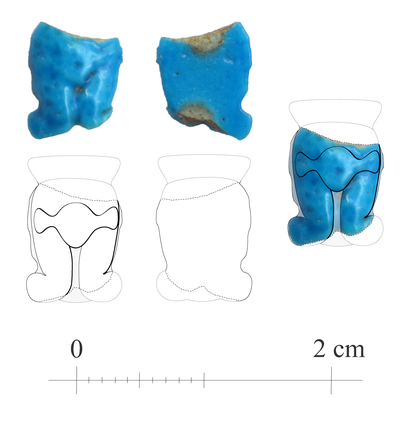About 2,500 years ago, on the hill of San Vicente, in the center of the old city of Salamanca, stood a peculiar walled village, occupied at the beginning of the Iron Age (900-400 BC).
It was presided over by a large circular adobe house where the lord of the town resided and which was surrounded, in turn, by the houses of his sons and daughters-in-law.
Now, the multidisciplinary team led by Antonio Blanco (University of Salamanca), Cristina Alario and Carlos Macarro (Salamanca City Council) has excavated this house and has found, among other materials, a surprising amulet representing the Egyptian goddess Hathor, the deity of love, fertility, and above all, of the West.
How and why did it get there?
More information
The airport that landed on a monument
The hill of San Vicente, bathed by the river Tormes, has been excavated since 1990. In 2006, works were carried out that left the main farmhouse visible, which is currently open to visitors. But investigations have resumed this summer in that sector and have focused on housing, with results that experts describe as "exceptional."
The town was made up of adobe buildings: houses (both circular and rectangular) presided over by a central hearth and a running bench inside, measuring approximately 30 square meters. Its small size makes experts think that it would be conjugal dwellings (occupied by a couple and their offspring). Its arrangement in a huddle, with doors that open onto a common central space, and the presence of small shared structures (warehouses, silos, barns) “fit in well with the spatial pattern that anthropological studies associate with a virilocal domestic group; that is to say, of men united by a patrilineal affiliation (the parent and their children or siblings living together), while the women left their native village when they married ”, the archaeologists told this newspaper.
Amulet of the Egyptian goddess Hathor, found in Salamanca.
The 2021 campaign has focused on the “extraordinary house” of the patriarch.
In the previous three decades, a score of buildings had been excavated, but none like the one investigated now: instead of a running bench it has two, it was occupied "for centuries", it had a "huge central hearth with a trapezoidal shape, reminiscent of an extended bull hide with Tartessian connotations (something that was not known north of the Tagus River) ”, and was intentionally burned as part of a ritual in the 6th century BC.
C. "After the fire, its interior was filled with adobes from the walls, carefully placed on a rope in concentric courses," the experts recall.
Inside the building has also been found "an unusual abundance of mills for grinding cereals", which could indicate communal meals, two whole lamps and abundant fine painted tableware, possibly to entertain guests.
The pots carry lively pigments in red, white, yellow and blue, with decorations that refer to the eastern Mediterranean (palmettes, lotus flowers and stars) and that were made in the same house.
In addition, imported materials, common in Phoenician and Tartessian sites, have been exhumed: turned Phoenician ceramics, censers, tripod bowls (for grinding spices) and terracotta liturgical objects.
Intense social activity
But among all this, the findings of "necklace beads and an amulet representing the goddess Hathor stand out, as well as a piece of a bowl, probably Egyptian, all made of an opaque blue synthetic paste with a white core called faience." These fayenzas were made in Egypt or on the Syrian-Palestinian coast, according to Linda Chapon (University of Montpellier), and traveled more than 5,000 kilometers until they reached Salamanca "through exchanges with the Phoenicians."
"All these findings," the archaeologists point out, "suggest that the patriarch's house was home to intense social activity, where banquets were held for guests and exotic objects arrived." “A hypothesis that we are considering”, affirms Juan Jesús Padilla, from the University of Salamanca, “is that the hill was much better connected than we had thought with the long-distance routes of iron and tin, metals that were in high demand at the time and that through them, knowledge, objects and customs of the eastern Mediterranean will arrive ”. Then the patriarch used or received them as a gift or exchange at his parties. Including the goddess of love, music and the West.

